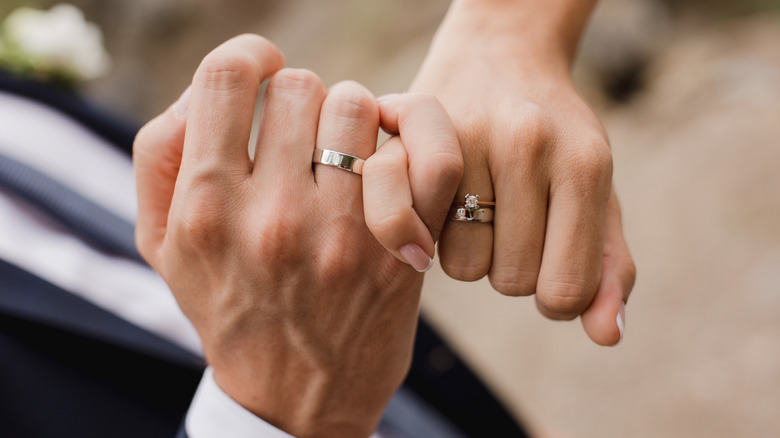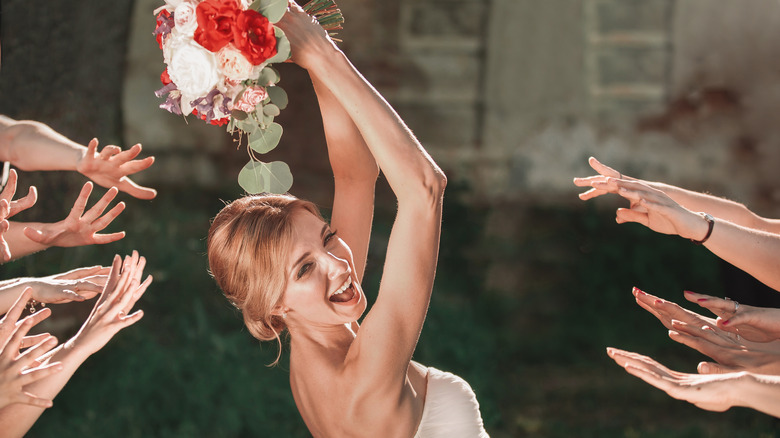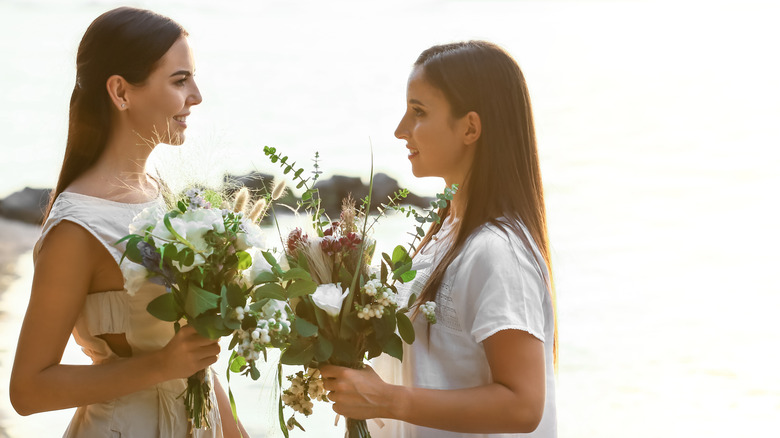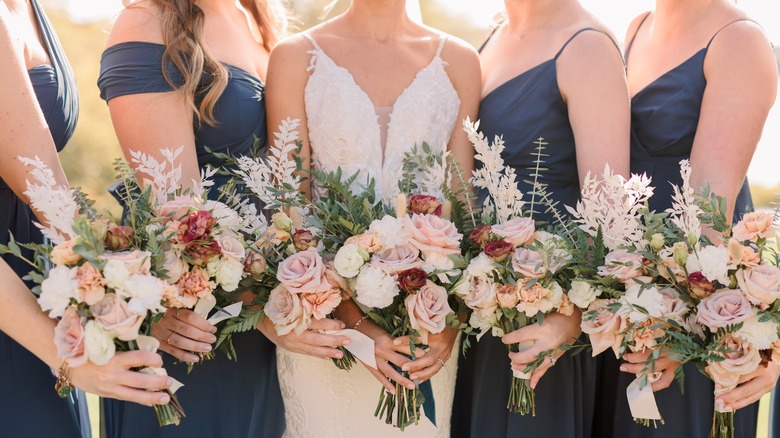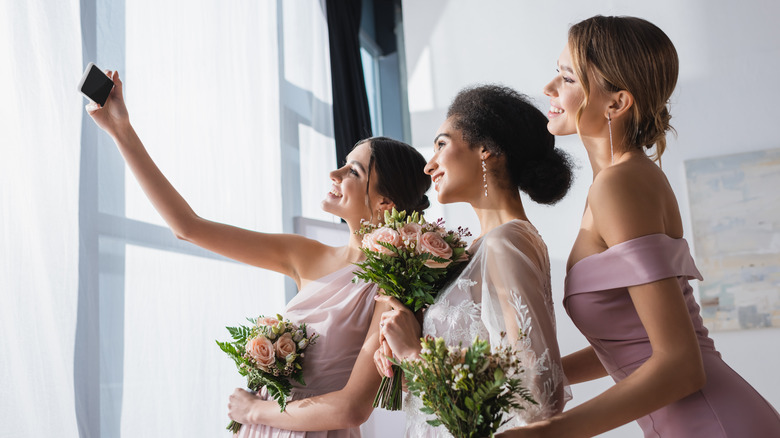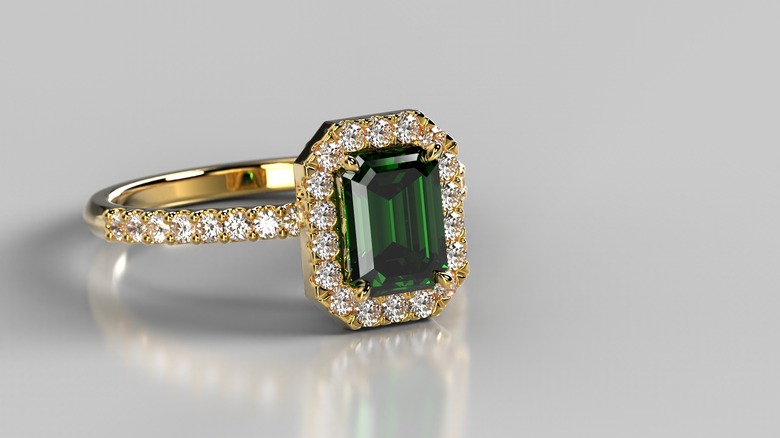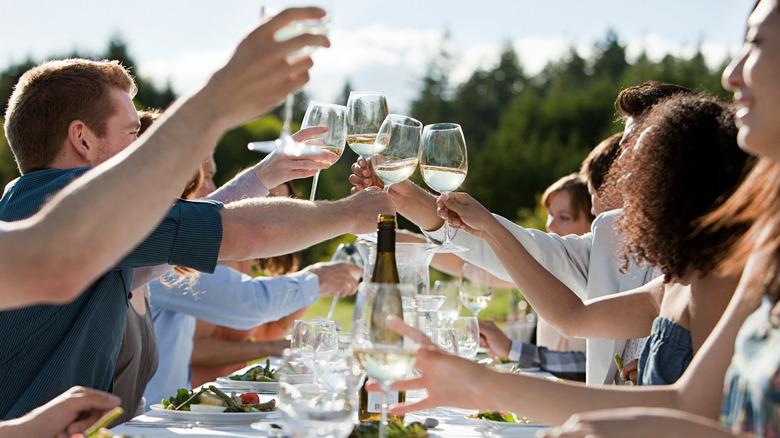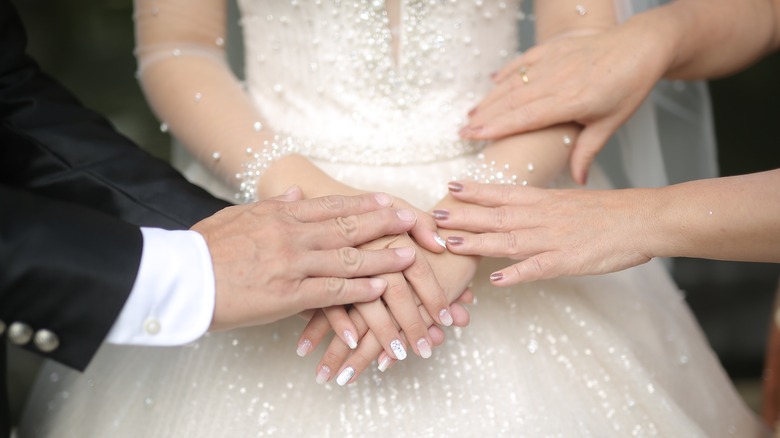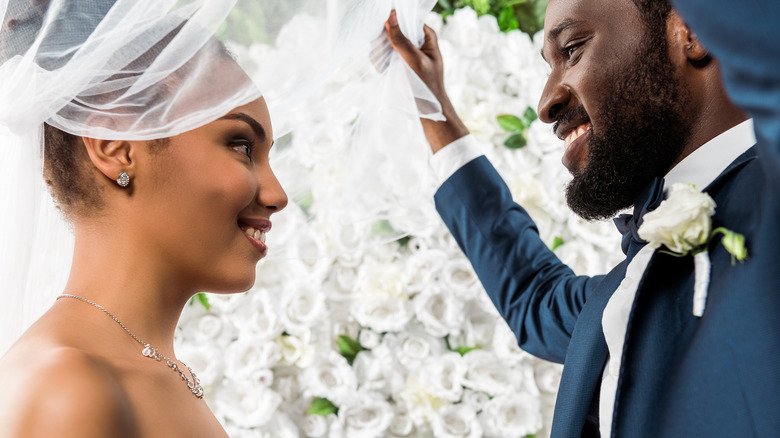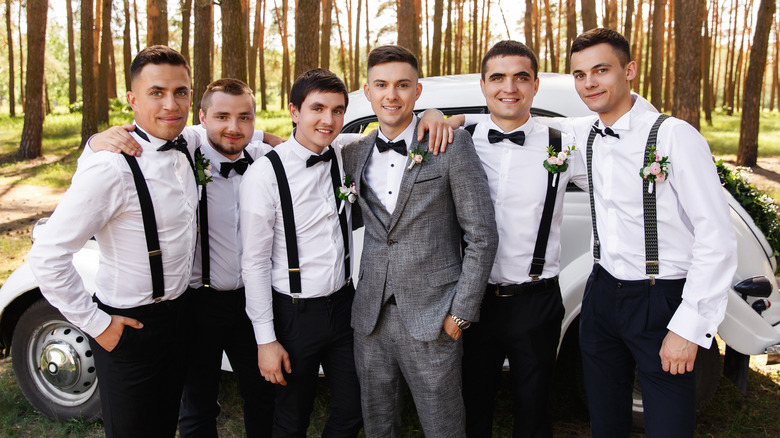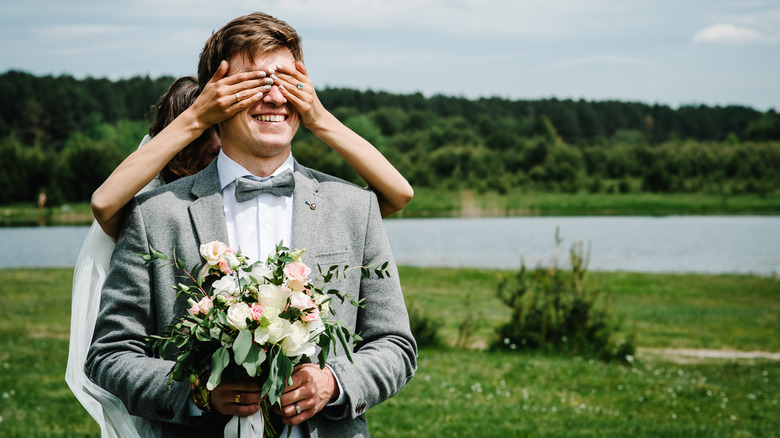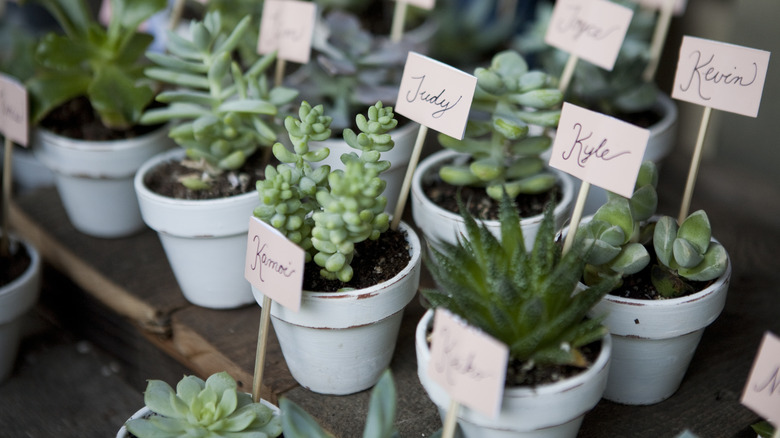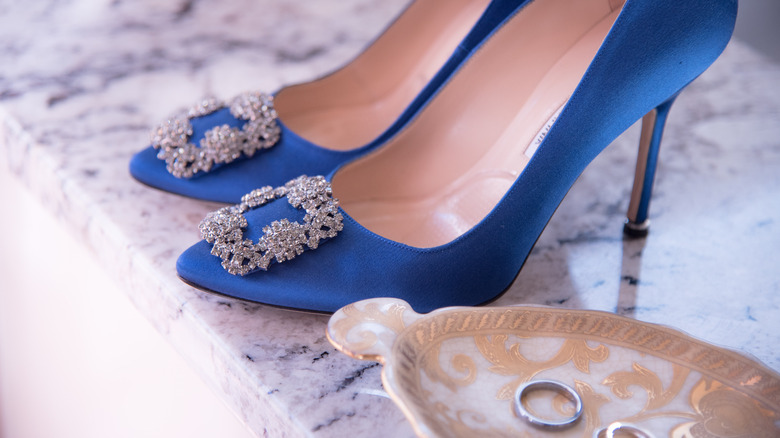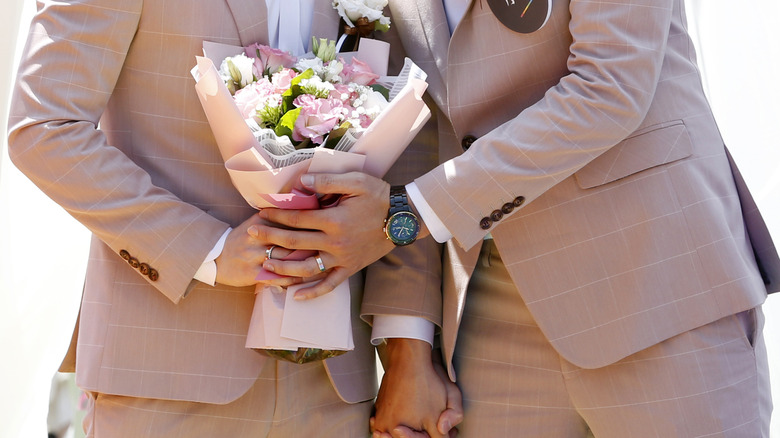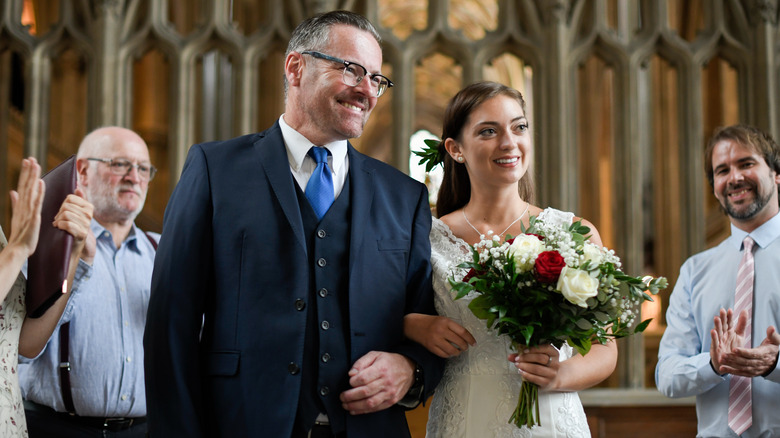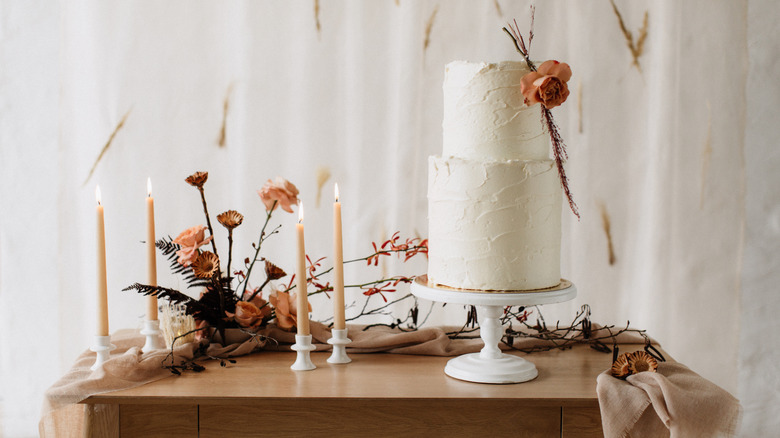15 Wedding Trends And Traditions That Are Totally Outdated
Wedding ceremonies are full of symbolic gestures and grand traditions, many of which date back hundreds, if not thousands, of years. According to Bridal Guide, most aspects of a wedding ceremony are so ingrained in our culture that we don't even really notice them. But where exactly did those traditions come from? Who determined that the bride must wear white, or that the couple getting married aren't allowed to see each other until the ceremony? What is the purpose of a same-sex bridal party, and why do they all have to look identical?
A number of odd beliefs and superstitions surrounding weddings have come about in the past few centuries, some of which have creepier intentions than others. However, just because something has always been done one way doesn't mean it's right for your celebration. While wedding superstitions and outdated trends once had their place, there isn't anything wrong with doing away with something that doesn't suit you and your partner (via The Knot). If you and your partner want to celebrate your way with a modern ceremony, here are 15 outdated wedding trends and traditions you should feel free to skip on your big day.
Garter toss and bouquet toss
The garter toss and bouquet toss are typically some of the first outdated traditions to go at modern weddings. The garter toss is the groom's equivalent of the bridal bouquet toss. According to wedding dress designer Maggie Sottero, a modern wedding garter is a decorative piece of lingerie worn under the gown around the bride's mid-thigh, typically removed by a groom at the end of the reception. After medieval weddings, guests would attempt to rip off the bride's clothes to snag a piece for themselves, something that was said to bring them good luck. Over time, the garter was tossed among the guests. Whoever caught it was said to be the next to get married (via The Garter Girl). Although some brides like the raucous reception tradition, the sentimentality, or the sensual effect of a garter for their wedding night, it is becoming more common for brides to skip the garter toss entirely.
The bouquet toss tradition is also losing popularity. In medieval England, when the guests attacked her for pieces of her clothing, the bride would throw her bouquet to distract them and redirect the mob-like gathering (via Dubsdread Catering). Similar to the garter toss, the person who caught the bouquet was blessed with good luck. Nowadays, bouquet tosses symbolize a single woman's chance to get married. Some brides don't like how modern bouquet tosses call out single women to the dance floor or the strange competition it is known to introduce.
Traditional vows
Generally speaking, wedding vows are a ritualistic exchange of promises between the couple getting hitched. Traditional vows include well-known phrases like "for richer, for poorer," "till death do us part," and, if you are a woman, "to love, cherish, and obey." According to Zola, the wording of these traditional vows didn't exist until the Catholic church recognized marriage as an official sacrament. These vows were written in The Book of Common Prayer in 1549, and little has changed in the years that followed.
Traditional wedding vows are often a feature of faith-based weddings, and depending on where you get married, may be a requirement of the church or person' marrying you. However, many modern couples dislike the formal language and the sexist undertones of some of the individual vows. As a result, many couples are opting to write their own vows that are unique to their relationship. These vows are often more personal and come straight from the heart (via One Story Weddings).
Writing your own vows requires some forethought and attention, but it doesn't mean they have to be incredibly deep or bring everyone watching to tears. If you are a couple that is nervous about public speaking or aren't confident in your writing abilities, you can also combine your vows. Pick and choose the parts of traditional vows you like with elements of personal vows that you write yourself.
Gender-specific wedding parties
Bridesmaids have played an important role for brides since biblical times. According to WeddingWire, in the story of Jacob, his wives Rachel and Leah were escorted to their wedding by servants. The bride's maids weren't related to the brides at all. Their role was literally to serve the bride on her wedding day and attend to her needs. During the Victorian Era, bridesmaids were responsible for organizing decorative, festive favors for guests. They also walked down the aisle with aromatic bouquets of herbs and garlic to scare away evil spirits. These bridesmaids traditionally wore white alongside the bride and short veils.
Needless to say, the need for bridal look-alikes to ward off evil and or serve the bride isn't necessary anymore. So why not mix up your wedding party? If you have friends and relatives of the opposite sex who have played an important role in your life, and you want them to stand beside you while you get married, you should include them in your wedding party. Tonia Adleta of Aribella Events explained to Vogue that brides should "...spend time reflecting on what you want and what would make you happy and go with what feels right. Prioritize your needs as a couple and put those above all else." Your best friends will still be your best friends regardless if they participate in your wedding or stand beside your little brother or male cousin during the ceremony.
Bridesmaids all wear the same dress style and color
In addition to all female bridal parties, bridesmaid tradition states that all attendees should wear the same dress style and color. This tradition dates back to ancient Rome. During this period, brides would often travel for days with their dowry to get to their betrothed. This made them a prime target for highwaymen. To protect the dowry and the bride, her bridesmaids would dress like her in an effort to confuse potential robbers. Romans also required a certain number of witnesses at weddings, which bridesmaids in their matching dresses fulfilled (via Mental Floss). These women were responsible for confusing the devil and evil demons who wished the couple harm.
According to Azazie, bridesmaids from the Anglo-Saxon period were responsible for making sure the bride got to the altar. Her maidens, who had to be virgins, helped the bride get dressed for her wedding day but wore similar colors to her so they could serve as stand-ins if need be.
Diamond engagement rings
Diamond rings have been a token of marriage proposal acceptance for centuries. According to the American Gem Society, the tradition started in 1477 when Archduke Maximillian of Austria commissioned a diamond ring for his betrothed Mary of Burgundy. The Victorians would later build upon the trend in their own sentimental way by mixing diamonds with other gemstones and metals, a trend that continued well into the Edwardian era.
Despite their widespread presence, diamond engagement rings didn't become mainstream in America until the 1930s (via Gemological Institute of America). With the help of a few Hollywood starlets, department stores and advertisers marketed the stone's durability, quality, and purity. They positioned the stone as a symbol of lasting marriage and succeeded in making diamonds the top-selling gemstone in the world.
In spite of their enduring popularity, many modern couples are ditching diamond rings in favor of other stones (via CNBC). Couples concerned with sustainability, ethical production, and one-of-a-kind products are looking to replace diamond engagement rings with emeralds, morganite, sapphires, and rubies. Some brides feel stones other than diamonds more accurately reflect their personalities. Others recognize the severe impacts of diamond mining, including environmental devastation and the exploitation of miners, and want a ring that aligns with their values. Diamonds may be forever, but that doesn't mean you have to wear one if your preferences or tastes differ.
Formal rehearsal dinners
In western culture, it is common for a formal dinner to precede a couple's wedding ceremony. This dinner normally follows an official wedding rehearsal, where the people involved run through the ceremony step by step. The dinner is a celebration of the ceremony to come, but it is also seen as a way to honor your bridal party, close friends, and immediate family members for their support (via The Knot). Traditionally, this dinner is paid for by the groom's parents.
However, many modern couples who are paying for their own weddings are unsure about the need for a formal rehearsal dinner. According to Bridal Musings, a rehearsal dinner can be a costly added expense to what is already an expensive event. A formal, dressy, semi-stuffy dinner at a restaurant is also not every couple's vibe. If you want a rehearsal dinner but are looking to skip the fanfare, there are dozens of ways to personalize this specific event. Keep it casual with a bonfire or potluck dinner with your favorite people, spring for tickets to a sporting event, or host a pool party. No matter what you choose, remember there are no rules, and every event surrounding your wedding should be exactly what you want it to be.
The bride's parents pay for the wedding
Historically, the majority of wedding expenses were taken care of by the bride's parents (via Emily Post Institute Inc.). Everything from transportation and floral arrangements to the photographer and wedding invitations fell under their responsibility. The tradition stems from the days of dowries when the bride was viewed as her father's property. The groom's family would receive a number of gifts, including jewelry, money, and even livestock to make the marriage more appealing.
Cultural and societal shifts over the years have largely eliminated this practice. Brides are not viewed as burdensome property and many couples live together long before they marry. LGBTQ+ couples who can't split wedding financials along gender lines also have to get more creative in terms of who will pay for what (via WeddingWire). Although the majority of couples receive some kind of financial help when it comes to spying for their wedding, it is no longer a given that the bride's family must shoulder the bulk of expenses. Many couples choose to pay for the entire day on their own. Before jumping into planning, you and your partner should talk with your family members about the wedding budget and determine if or what each party plans to contribute.
The bride must wear white and a veil
Although there are records of royal brides wearing white dresses throughout history, the white dress has only been a fixture of weddings since the mid-nineteenth century. In 1840, Queen Victoria wore an ivory dress with a tight v-shaped bodice, elegant lace sleeves, and a full silk skirt during her wedding to Prince Albert (via JSTOR Daily). The young couple's highly-publicized wedding showcased both their love and shined a positive light on the monarchy. As a result, white wedding dresses gained massive popularity and became a lasting tradition (via Fashion History Timeline).
Despite its enduring popularity, many modern brides are falling head over heels for colored dresses. Some brides dislike the Victorian ideals surrounding purity and innocence associated with white dresses. Others simply prefer colors that more accurately reflect their personalities and sense of style. Dresses in shades of pink, lavender, and pale blue are projected to be popular in 2023, according to The Knot.
Wedding veils have a less concrete history, although their use can be traced back to ancient Rome. Traditionally, these veils were a yellow color that helped disguise the bride's face from evil spirits (via Brides). Veils currently hold significance in certain cultures. However, like white dresses, they are not a mandatory part of most brides' attire. Instead, a veil can be a lovely accessory without any rules as to what it should look like.
The groom and groomsmen wear full suits
Like brides, grooms and their groomsmen have attire they are traditionally expected to wear. According to Wedding Forward, groomsmen have historically been restricted to wearing tuxedos or suits that matched the groom. Many modern couples are ditching formal matching suits for a more casual, but still cohesive, look. Terence To, the vice president of sales and marketing at Brooklyn Brigade, told Brides, "You might see the groomsmen wearing a vest instead of a suit jacket. Maybe [the groomsmen have open collars (no tie) and [are] wearing suspenders instead of belts."
Casual weddings are becoming increasingly popular, with one in five couples opting for a more relaxed ceremony and reception (via The Knot). These chill events are full of fun and entertainment that more accurately reflect the personalities and lifestyles of the couple getting married. They also don't require three-piece suits or cummerbunds. If you need help choosing what the groomsmen in your wedding wear, consider the theme or overall styling of your wedding. Matching suspenders and jeans would be appropriate for a rustic, country-style wedding, while a vest and bow tie might suit a boho-chic wedding.
The couple can't see each other before the ceremony
More and more couples are straying from the centuries-old wedding tradition that prohibits the couple from seeing each other before the ceremony. According to California-based wedding planner Bridget Davis Events, this tradition dates back to the 18th century when most marriages were arranged. Prohibiting the couple from seeing each other before the wedding kept the groom from running off should he not find his future bride suitable (read: attractive). Over time the tradition transformed into a superstition that claimed it was bad luck to see one another before the ceremony.
Nowadays, many couples are opting for first looks. These sweet, private moments before the ceremony are normally just between the couple and their photographer. The couple gets to see one another, calm their nerves, and enjoy some special time alone on their big day (via Nikki Kate Photo Co.). Furthermore, first looks are an excellent opportunity for couples to get their wedding portraits completed. Traditionally, wedding portraits take place while the guests enjoy cocktail hour. However, more and more couples are wanting to take part in the festivities.
Some couples worry doing a first look will take away the special feeling the ceremony reveal traditionally holds. However, photographer G.E. Masana explained to Huff Post that "spending time together earlier on in the wedding day ramps up and fuels the emotions for when the magic moment finally comes when you see each other at your ceremony."
Wedding favors
Traditionally, couples would provide wedding favors for their guests as a thank-you for celebrating with them. According to Yeah Weddings, favors were seen as an obligatory commemorative ritual that potentially added a bit of fun or whimsy to your event. Due to their cost, they were an obligatory commemorative ritual reserved for the wealthy.
While there is nothing wrong with thanking your guests for their support on your big day, favors are no longer expected to be pretty net bags of Jordan almonds. Modern favors are normally more personal to the couple. They can include everything from customized picture frames and bottle openers to bags of dog treats for guests' furry friends. These cute customizations cost a pretty penny. According to What It Costs, most couples spend between $1-$5 on favors, which can add an additional $500 to your budget.
In lieu of wedding favors that guests may not like or keep, couples are offering favors that enhance their guests' experience. Photo booths, custom playlists made up of guest recommendations, and food are becoming more popular favors per Rustic & Main. Some couples choose to take the money they would normally allocate to favors and make donations to charities of their choice.
Something old, something new, something borrowed, something blue
The adage "something old, something new, something borrowed, something blue" is a long-held wedding day superstition. It was said that a bride needed to have all four items with her when she got married in order to have a long and successful marriage (via Forever & Company). These items can either be worn or carried.
Something old was a family keepsake that symbolized the bride carrying her past with her into her marriage. Something new, which is typically the bride's dress, perfume, or jewelry, symbolizes a hopeful future for the bride and groom. According to The Pioneer Woman, the "something borrowed" was an item that came from a happily married family member or friend. This trinket was said to bring fertility and good luck. Perhaps the most outdated tradition from this rhyme is the "something blue." The color blue was considered to be a symbol of fidelity, love, and purity. It was also a way to ward off the evil eye and protect against harm and bad luck.
Although many brides like the rhyme, they no longer hold stock in its outdated superstition. Some choose bits and pieces they like best, but many have done away with these traditions altogether.
Flower bouquets
Flower bouquets have been a standard part of a bride's outfit for thousands of years. According to Modern Wedding, brides in ancient Rome wore flower garlands to symbolize new beginnings and fertility. During the Middle Ages, English brides carried bouquets of herbs and spices that symbolized fertility, luck, and lust (via Weddingbee). The fragrant bouquet was also used to ward off evil spirits and mask the smell of body odor. It wasn't until the Victorian era that flower bouquets became symbols of a bride's romantic hopes and dreams for her marriage. These flowers would become the bride's "flowers" for the duration of her life, so they were chosen with extra care.
Nowadays, flower bouquets are less a symbol of romance and more an expression of a bride's personal style. However, some brides are doing away with the bouquet tradition entirely. Alternatives to bouquets include floral hoops, sparkling brooch bouquets, feathers, bouquets made with dried florals and branches, and greenery-only bouquets like ferns or tropical leaves. Some brides choose to carry sentimental items, like a book or a lantern.
Being given away
The ritual of a bride being given away by her father is a timeless tradition, although it has a bit of a transactional undertone. The tradition has roots in ancient patriarchal cultures where young women were seen as their father's property. During the wedding ceremony, being given away symbolized the father transferring ownership of his daughter to her future husband (via Bright Hub Education).
Being given away by her father is a sentimental ritual that many brides look forward to (via Vow Muse). It is less of a contractual agreement and more of a symbolic blessing. However, that doesn't make it right for every bride. According to A Different Officiant, some weddings have two brides while some feature couples that do not identify as a bride or a groom. Some people don't have great relationships with their fathers, while others have two. Many modern women simply don't agree with the misogynistic history behind the tradition.
As an alternative, more brides choose to walk down the aisle alone or with both of their parents. Many opt to alter the language spoken by the officiant at this portion of the ceremony as well. Exchanging the words "who gives this woman to this man" for something like "who supports this union" or "who presents this woman" are becoming more popular versions.
Having a wedding cake
Wedding cake is a beautiful addition to a couple's nuptials, but the exorbitant price has many couples questioning their necessity. According to Smithsonian Magazine, the origins of wedding cakes are quite humble. Medieval couples would kiss over a pile of buns to symbolize prosperity, while ancient Greek and Roman grooms would smash barley cake over the bride's head. Victorian-era cakes gradually became more elaborate, featuring towering tiers, delicate icing, and unique flavors.
For couples that don't like cake or don't want to spend the money on a garish tower of frosting, there are plenty of alternatives that guests will love. For example, doughnut walls, cupcake or macaron towers, and platters of cookies are all tasty treats significantly cheaper than a bakery cake (via Wedding Forward). Couples that prefer pie can offer their guests different flavors, while the more ice-cream-oriented folks could offer build-your-own sundae bars. Dessert tables are also growing in popularity, allowing guests a mixture of bite-sized desserts they can sample throughout the reception.
